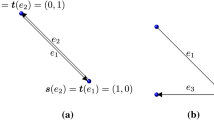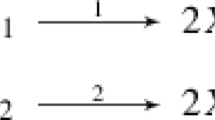Abstract
Kinetic models using enzyme kinetics are developed for the three ways that Louie proved that Rosen’s minimal (M-R)-System can be closed to efficient cause; i.e., how the “replication” component can itself be entailed from within the system. The kinetic models are developed using the techniques of network thermodynamics. As a demonstration, each model is simulated using a SPICE circuit simulator using arbitrarily chosen rate constants. The models are built from SPICE sub-circuits representing the key terms in the chemical rate equations. The models include the addition of an ad hoc semi-permeable membrane so the system can achieve steady state fluxes and also to illustrate the need for all the efficient cause agents to be continually replaced. Comments are made about exactly what is being simulated.

























Similar content being viewed by others
Notes
Many other more complicated forms of enzymatic reactions are possible involving multiple active sites on the enzyme with possibilities for both activation and inhibition.
Law of mass action—even though the law was originally developed for the equilibrium condition, the definition of the flow terms also has applicability when a system is not at equilibrium assuming that the reactions under consideration are sufficiently slow and close to equilibrium.
Network Thermodynamics—from Mikulecky (1993, p. 1) “Network Thermodynamics is a new field which arose out of the marriage of electrical network theory with the formalism of non-equilibrium thermodynamics”.
The program TopSpice: http://www.penzar.com was chosen because it had a free evaluation version that could be used for non-commercial purposes and also because it had a nice graphical user interface in which to develop the circuits. Additionally, both the circuit diagrams and the plotted output could be rendered in vector files that with only a small amount of editing could be (and were) used in this paper. Note, though, that there are other venders of SPICE that could also have been used.
One mole is approximately 6.022 × 1023 items of something. It is defined as Avogadro’s Number which is the number of particles in 12.000 g of carbon-12.
A materially closed system could avoid equilibrium with an inward flux of energy. Here, though, we are assuming that any energy would come in the form of materials (chemical energy).
Note that since these simulations are meant only as demonstrations, we didn’t bother to change the rate constants for the different realizations. In general, though, each different realization would be expected to have different rate constants which could be passed to the sub-circuits. Additionally, each enzyme sub-circuit within a particular realization would really be expected to have different rate constants than the other two. In these simulations, though, we simply reuse the same enzyme sub-circuit with the same default rate constants. We do, though, change the initial product concentration through the IC parameter.
Sensitivity analysis—the study of how the output of a model is affected by variations in the input (or parameters) of the model.
References
Cardenas ML, Letelier JC, Gutierrez C, Cornish-Bowden A, Soto-Andrade J (2010) Closure to efficient causation, computability and artificial life. J Theor Biol 263:79–92
Cornish-Bowden A, Cardenas ML (2007) Organizational invariance in (M, R)-systems. Chem Biodivers 4:2396–2406
Louie AH (2006) (M, R)-systems and their realizations. Axiomathes 16:35–64
Louie AH (2009) More than Life Itself. Transaction Books Rutgers University, Piscataway
Louie AH, Kercel SW (2007) Topology and life redux: Robert Rosen’s relational diagrams of living systems. Axiomathes 17:109–136
Michaelis L, Menten ML (1913) Die kinetik der invertinwirkung. Biochem Z 49:333–369
Mikulecky DC (1993) Application of network thermodynamics to problems in biomedical engineering. New York University Press, New York
Olasagasti F, Moreno A, Pereto J, Moran F (2007) Energetically plausible model of a self-maintaining protocellular system. Bull Math Biol 69:1423–1445
Prideaux JA (2007) Exploring the temporal consequences of chasing the elements in Rosen’s relational diagrams. Chem Biodivers 4(10):2415–2426
Rosen R (1958) A relational theory of biological systems. Bull Math Biophys 20:245–260
Rosen R (1971) Some realizations of (M, R)-systems and their interpretation. Bull Math Biophys 33:303–319
Rosen R (1973) On the dynamical realization of (M, R)-systems. Bull Math Biol 35:1–9
Rosen R (1991) Life Itself: a comprehensive inquiry into the nature. Origin and fabrication of life. Columbia University Press, New York
Zaretzky AN, Letelier JC (2002) Metabolic networks from (M, R) systems and autopoiesis perspective. J Biol Syst 10(3):265–280
Acknowledgments
I would like to thank the reviewer for suggesting adding additional commentary which resulted in the sections on comparisons, optimizations, and realizations in nature.
Author information
Authors and Affiliations
Corresponding author
Rights and permissions
About this article
Cite this article
Prideaux, J.A. Kinetic Models of (M-R)-Systems. Axiomathes 21, 373–392 (2011). https://doi.org/10.1007/s10516-010-9121-0
Received:
Accepted:
Published:
Issue Date:
DOI: https://doi.org/10.1007/s10516-010-9121-0




